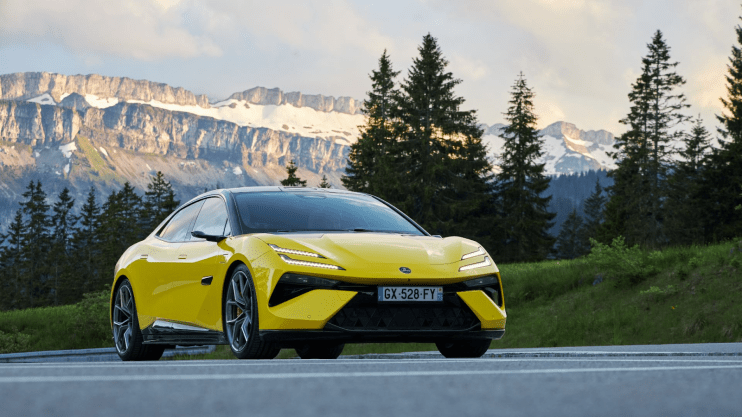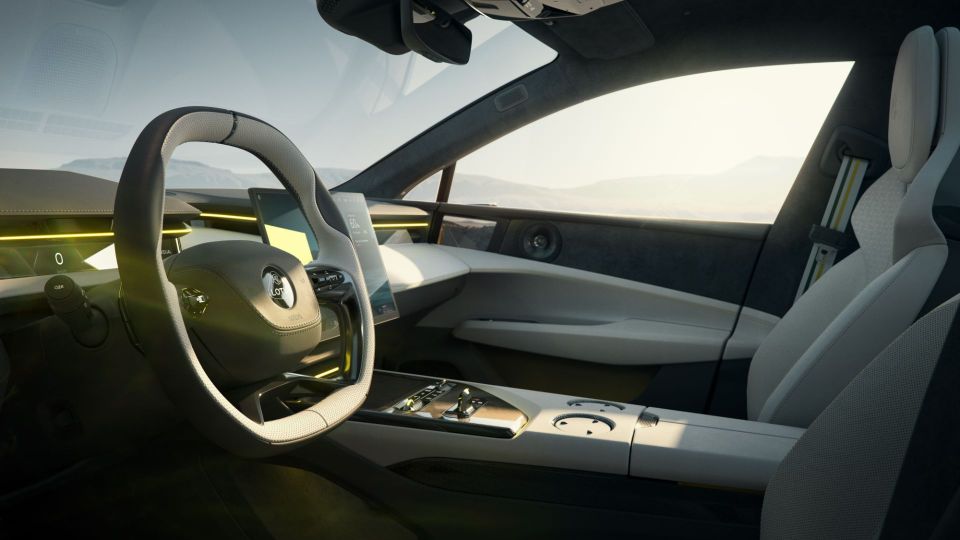Lotus Emeya review: Taking on the Taycan

All is calm as the Lotus Emeya sails past 150mph. With the horizon shrouded in heat haze, three empty lanes ahead and only a muted swoosh from the wind and tyres, it feels like being paused in suspended animation. Even as the scenery rushes past at two-and-a-half miles per minute.
Then, at an indicated 258kph, the serenity is shattered. The digital speedo flashes red and a buzzer sounds as the Lotus hits its speed limiter. The sudden uproar makes me jump, which isn’t ideal at 160mph. With palms now slightly sweaty, I steer across to the inside lane and settle to a 120mph cruise. We’re in no rush, after all.
Before you write in, this took place on a German autobahn, not on the M40. And while the Emeya’s top speed is irrelevant in the UK, the ease with which it gets there is head-spinning, awe-inspiring… even a little underwhelming. With 905hp and a 0-62mph time of 2.8 seconds, this electric saloon offers hypercar performance, delivered in smooth near-silence. Welcome to the brave new world of Lotus.
An electric ‘Hyper GT’
Lotus will sell two versions of the Emeya in Europe. The ‘S’ musters 603hp, uses a single-speed transmission and costs £101,950. But I’ve started out in the flagship Emeya R, which corrals the full 905 horses, has a two-speed gearbox and sells for £129,950.
Both cars use twin electric motors to provide four-wheel drive, plus a beefy 102kWh battery mounted beneath the floor. Range is a useful 379 miles in the ‘S’, but only 270 miles in the Emeya R – disappointing for a car billed as a ‘Hyper GT’. However, Lotus says the car’s grand touring capability is enhanced by the fastest charging of any EV on sale. Find a 400 kW DC charger and a 10-80 percent fill takes just 14 minutes.
Built in Wuhan, China, alongside the Eletre SUV, the Emeya competes directly with higher-powered versions of the Porsche Taycan and Audi E-Tron GT. Less sporting electric alternatives include the Mercedes-Benz EQS, BMW i7 and Tesla Model S. If you live in the US or mainland Europe, you can add the Lucid Air to that mix, too.
From Cortina to Carlton
A four-door family car seems far removed from the traditional Lotus DNA, but the Emeya does have several precedents. First, there was the Ford Lotus Cortina of the 1960s, which Jim Clark three-wheeled to victory in the British Saloon Car Championship. And let’s not forget the Vauxhall Lotus Carlton, which outraged the Daily Mail in the early 1990s with its 176mph top speed (yep, faster flat-out than the Emeya).
In the early 1980s, company founder Colin ‘Simply, then add lightness’ Chapman even proposed a six-seat limousine with active suspension, a 4.0-litre V8 engine and optional armour plating. Called the Lotus Eminence, sketches by ex-Pininfarina designer Paulo Martin show a futuristic shape not unlike the original Aston Martin Lagonda.
Speaking before the Emeya launch, Chapman’s son Clive said: “It was part of dad’s enduring ambition to always push Lotus forward into new areas. Often on the road, he was driving a Mercedes 6.9-liter saloon. I was aware of the Eminence project, which he started with Paolo Martin, but knew very little about it. But then dad died and that was that. And it’s taken this long for Lotus to make it to four-door territory. I know for sure that’s where Colin was wanting to take the company.”
Inside the Lotus Emeya

With all that in mind, let’s park any notions of what a Lotus should or should or shouldn’t be, and evaluate the Emeya for what it is.
Sadly, that isn’t a modern remake of the ‘wedge’ Lagonda, but the car’s angular, aero-sculpted and Lamborghini-like design certainly turns heads – especially in the Solar Yellow seen here. One fellow journalist nicknamed it the ‘Flying Banana’.
This is a large car – longer and wider than a Taycan – and the payoff is plenty of interior space. Rear-seat passengers can really stretch their legs, although a high floor makes the 509-litre hatchback boot disappointingly small. Quality feels like a match for the Porsche, while interesting options include a full-length dimmable glass sunroof, two individual rear seats (rather than a three-abreast bench) and an awesome 23-speaker KEF audio system.
The Emeya’s minimalist dashboard will be familiar to anyone who has driven the Eletre, with most functions centred on a huge and easy-to-navigate 15.1-inch touchscreen. The sat-nav system can plan your route around charging stops, calculating energy use and preconditioning the battery before you arrive.
With a total of four deployable lidar sensors, 18 radars and 12 cameras, the Emeya can even drive itself – if and when autonomous cars become legal. “All it requires is an over-the-air update,” explains vehicle line director Sylvain Verstraeten.
Open up and say ‘R’
For now, I’ll need to do the work myself, but escaping Munich traffic proves remarkably stress-free. In Tour mode – selected via one of the paddles on the steering wheel – the Emeya R rides very comfortably on its air suspension. Selecting from different levels of energy recuperation also means you can minimise use of the brake pedal around town. (although it doesn’t offer the true ‘one-pedal’ calibration of a Tesla). Then we hit the autobahn headed east and, well, you know what happens next…
Near the border with Austria, we stop at one of Europe’s many Ionity 350kW charging stations to refuel before climbing into the Alps. In the time it takes to use the bathroom, glug down a coffee and eat a cinnamon pastry (so, about 20 minutes), the Lotus has gone from 40 to 95 percent full. Impressive stuff, although it’s worth noting that fully replenishing that big battery using a typical 7.4kW home charger requires more like 16 hours.
When we finally reach some Alpine roads, I click into Sport mode and sense the Lotus tighten its muscles. It’s brutally quick, no doubt, with four-wheel-drive traction and the instantaneous torque characteristic of electric motors. Its responses feel almost hyperactively alert, but is it fun? I’m not so sure.
Ultimately, all the Emeya R’s clever chassis tech, including active anti-roll bars and rear-wheel steering, is trying to compensate for a kerb weight of 2,580kg. And yes, I’ve done the maths for you: that’s about five early Lotus Sevens or three S1 Elises. The result might be effective, but it lacks the fluidity and fidelity of the best cars from Hethel.
Lotus Emeya S is cheapest and best
The following day, we tackle the return journey to Munich in the identical-looking Emeya S. The experience, though, is anything but identical.
It might give away around 300hp to the Emeya R, but the ‘S’ is also around 100kg lighter. And with passive suspension and no rear-steering, it feels a more cohesive and more ‘Lotus’ car to drive. Its body movements are supple yet tightly controlled, while its steering has a tactility that the ‘R’ seems to lack.
Best of all, the Emeya S saves you £28,000 versus its more brutish brother. How about that for actionable consumer advice? And if Eletre SUVis anything to go by (currently available with zero percent APR), there could be some tempting finance deals in the offing, too. Taycan buyers should take note.
Tim Pitt writes for Motoring Research
Lotus Eletre S
PRICE: £101,950
POWER: 603hp
0-62MPH: 4.2sec
TOP SPEED: 154mph
KERB WEIGHT: 2,490kg
BATTERY SIZE: 102kWh
ELECTRIC RANGE: 379 miles